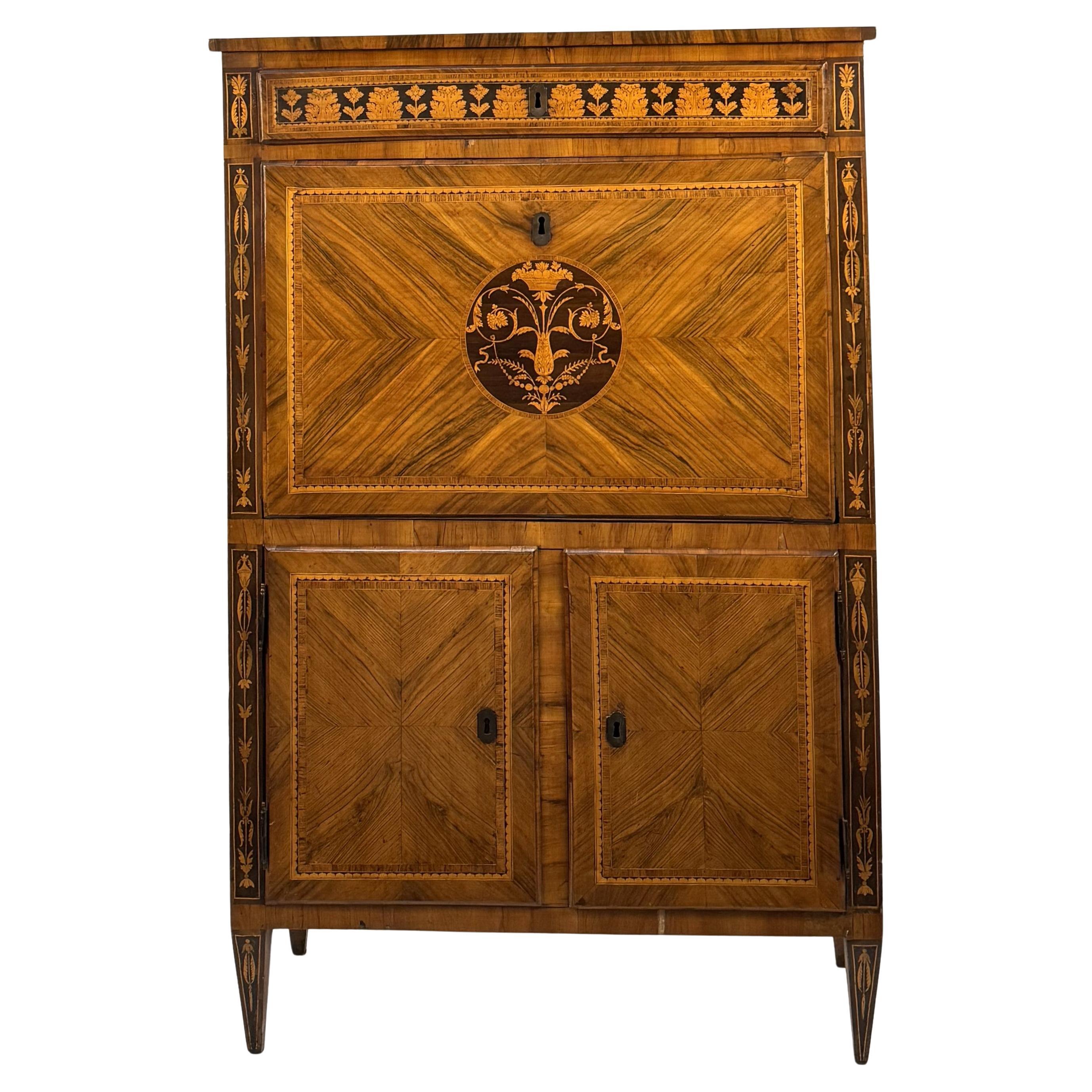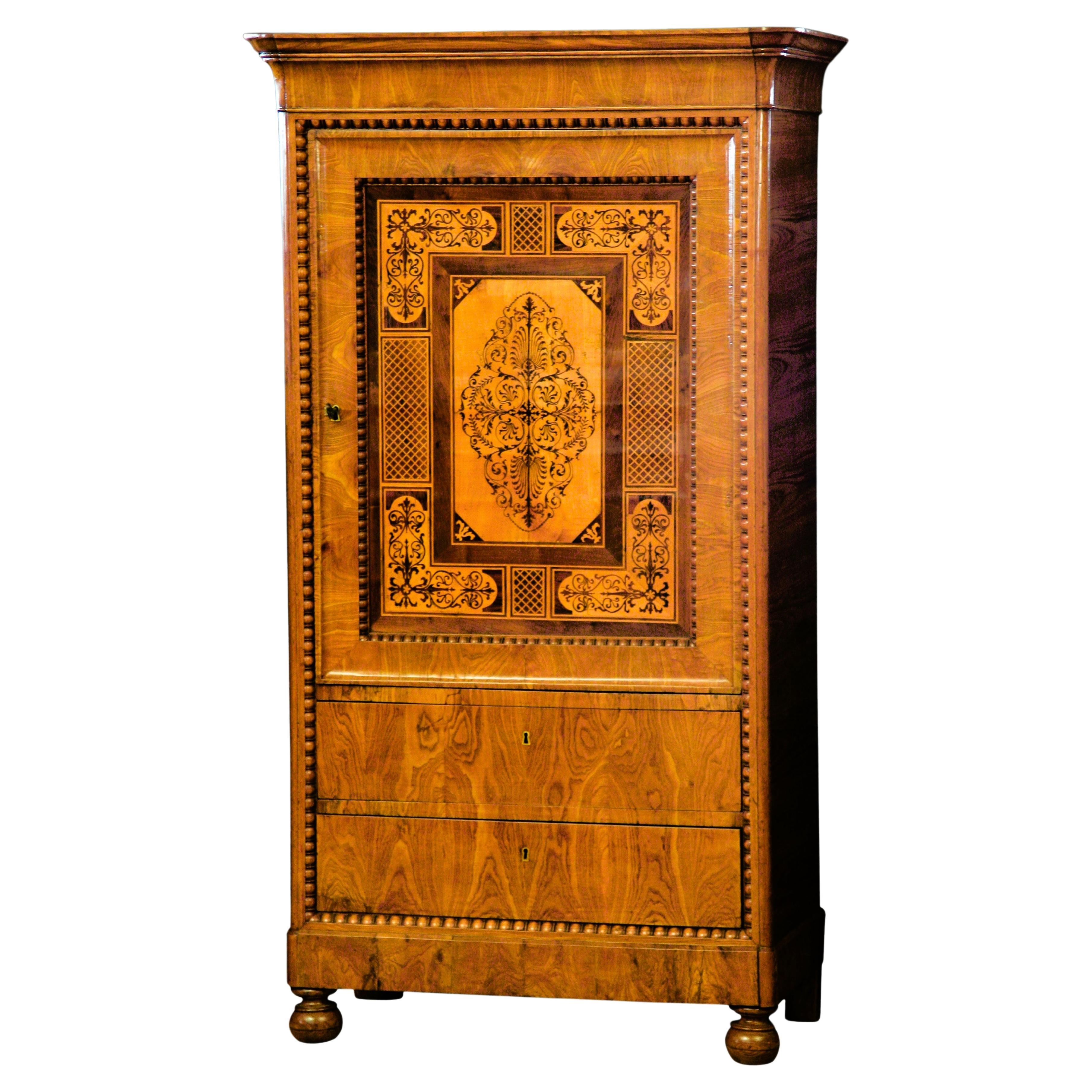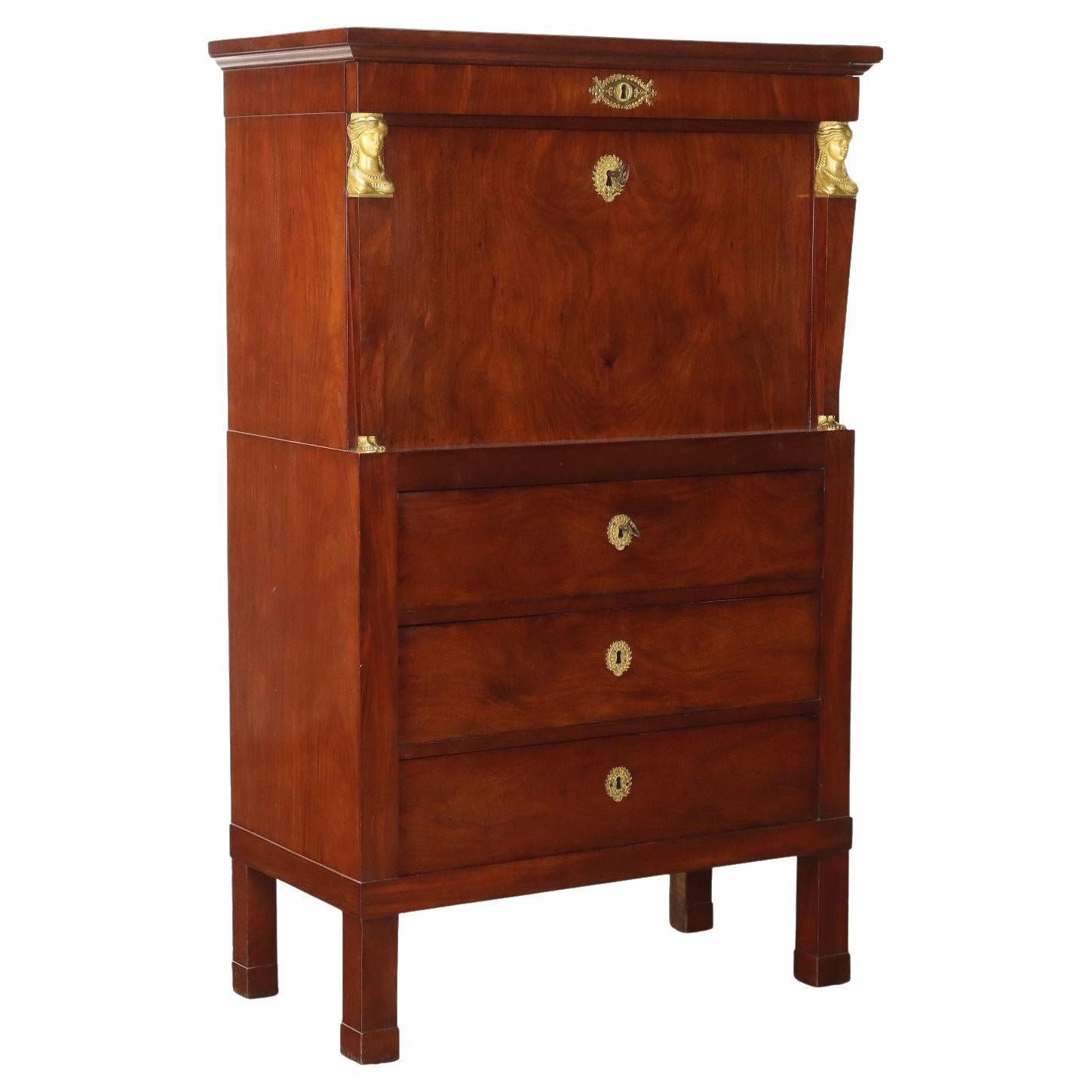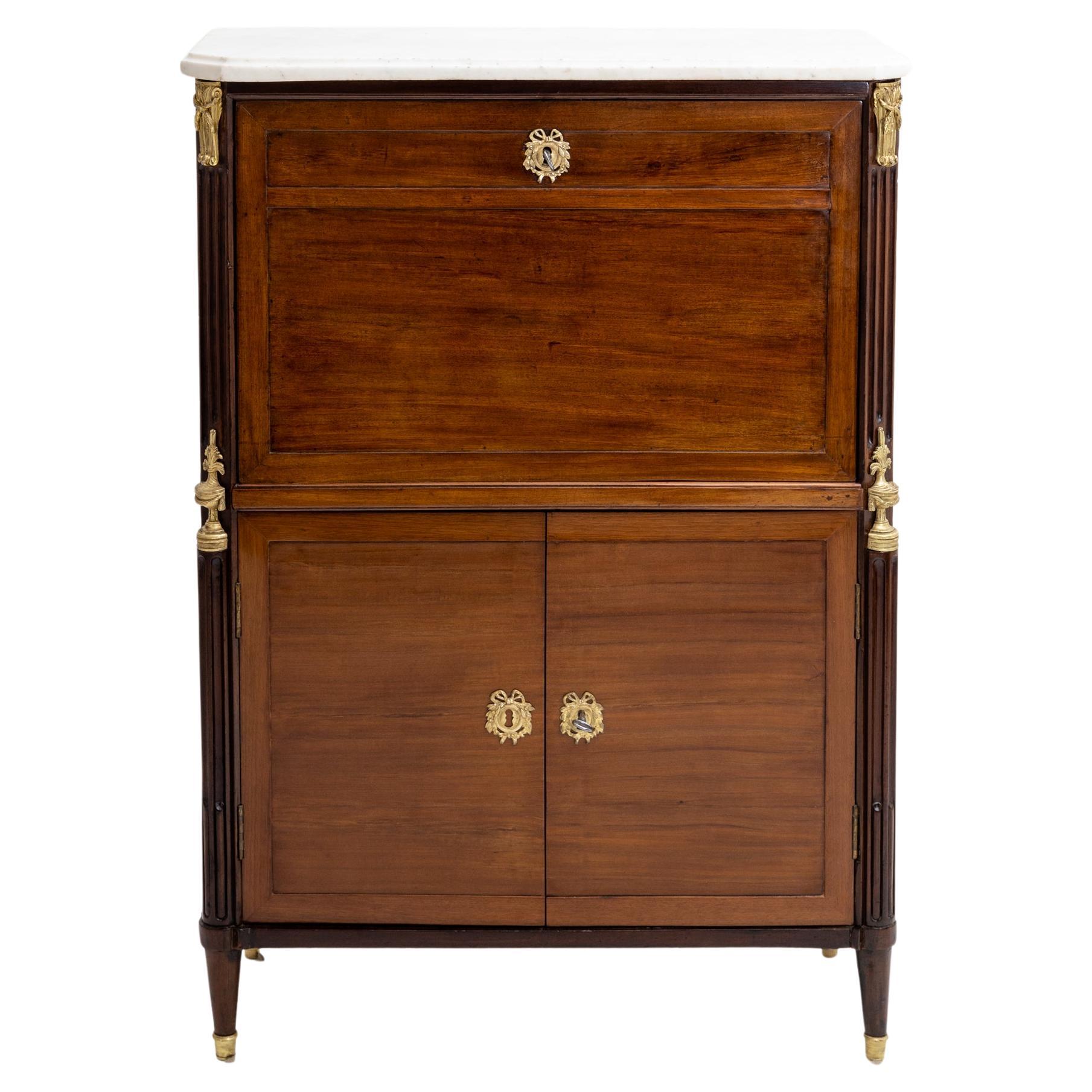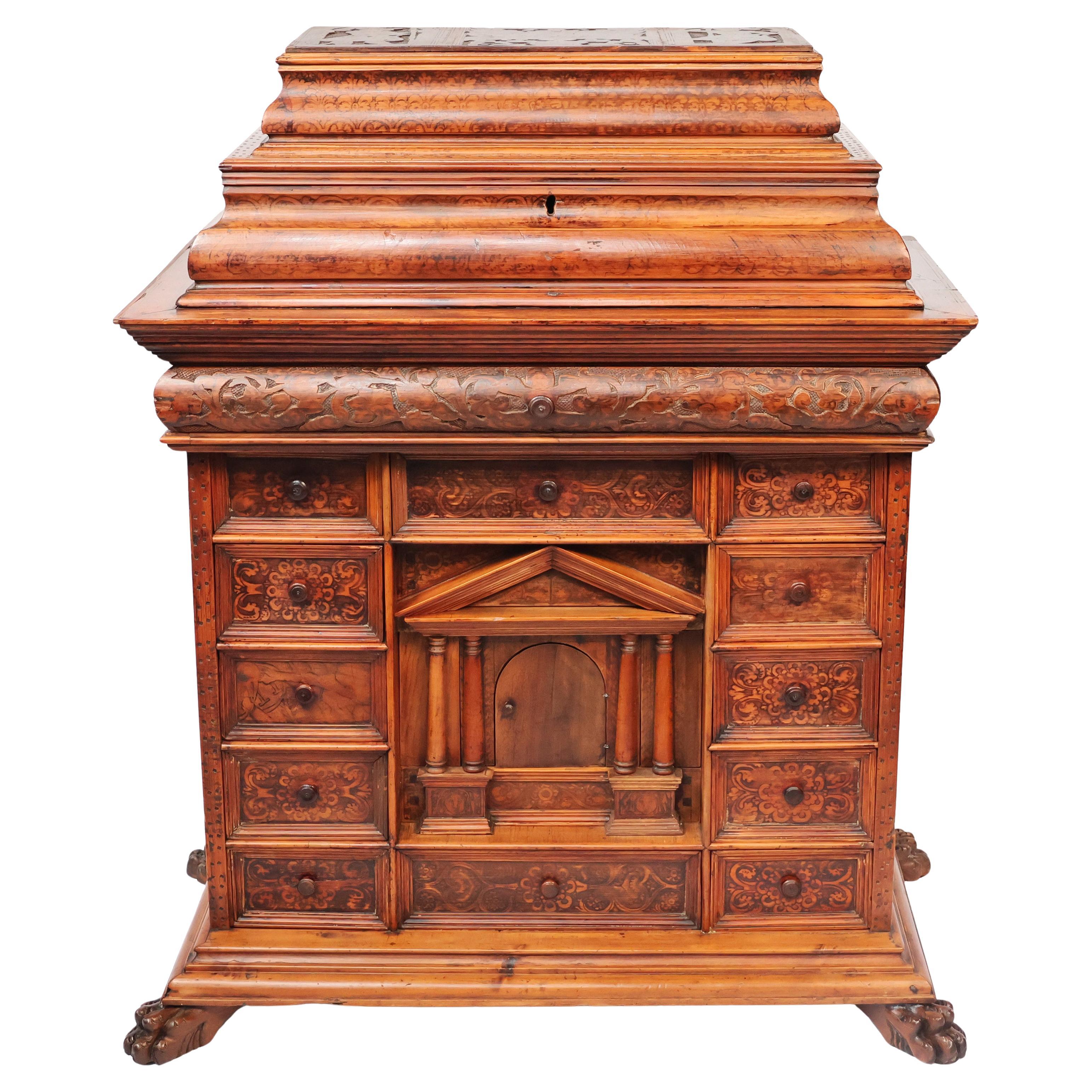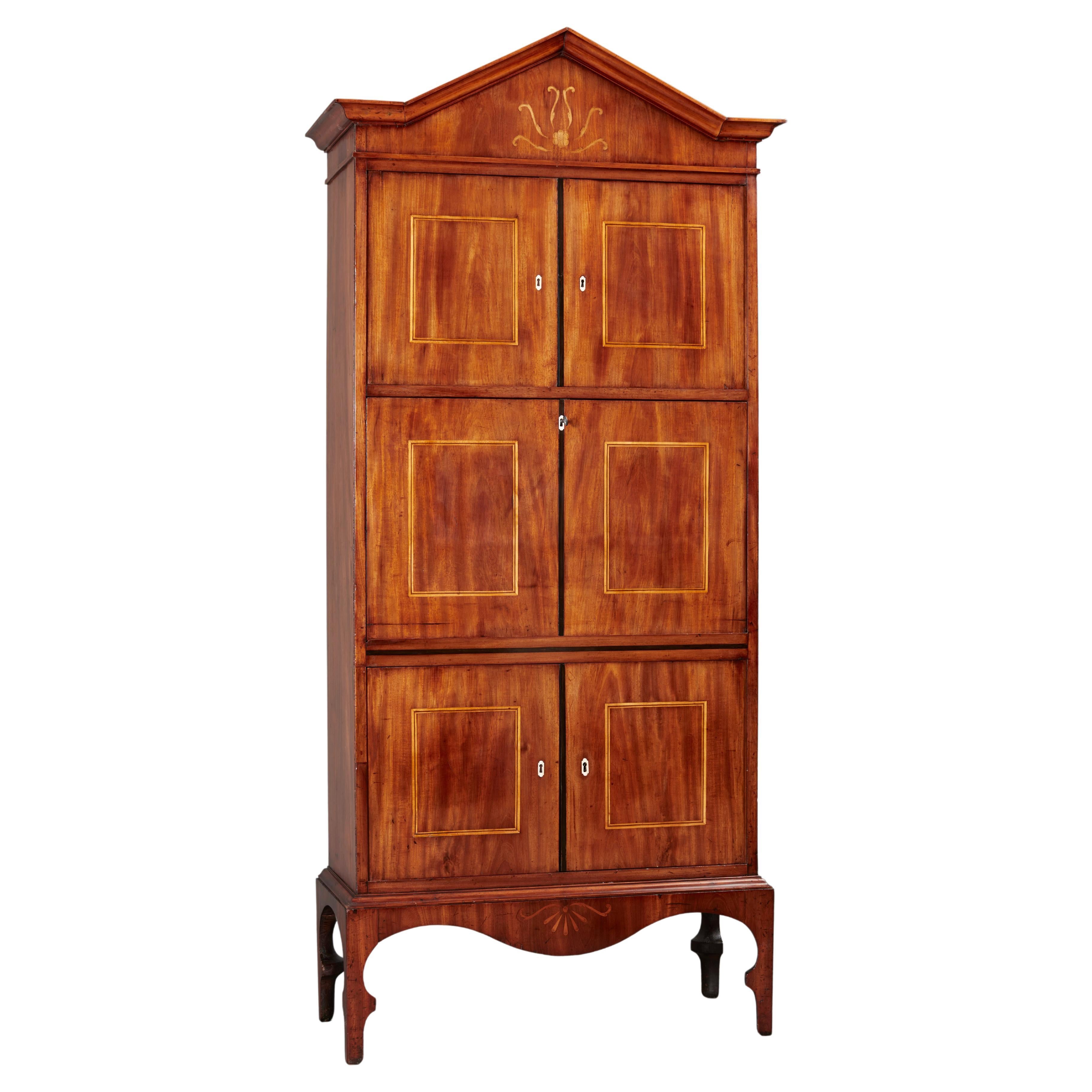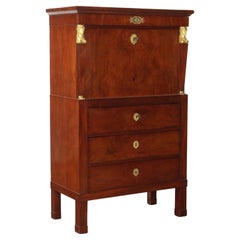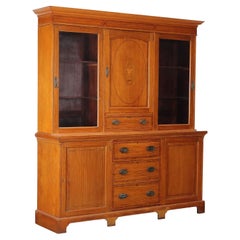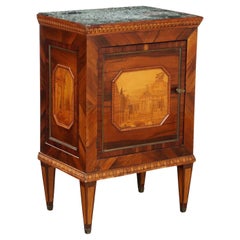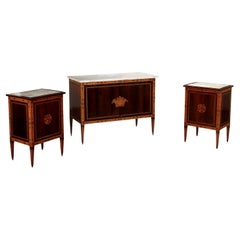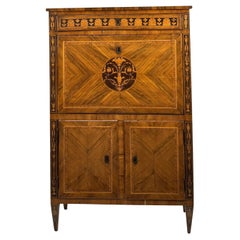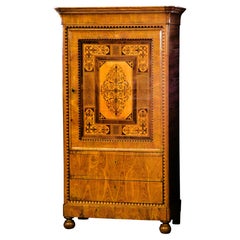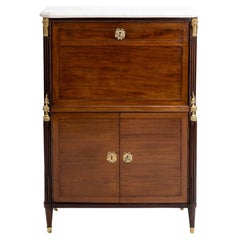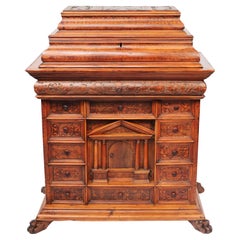Items Similar to Lombard inlaid secretaire Neoclassical 18th century
Want more images or videos?
Request additional images or videos from the seller
1 of 17
Lombard inlaid secretaire Neoclassical 18th century
$12,015.94
£8,895.42
€10,050
CA$16,627.05
A$18,330.95
CHF 9,590.16
MX$224,886.67
NOK 120,721.11
SEK 112,893.33
DKK 76,554.74
About the Item
Neoclassical secretaire made in the late 18th century. Made with two doors in the base, flap door with scarab and under-top drawer. Made of walnut and then veneered and inlaid in various woods, including walnut, hickory, rosewood, boxwood, maple, and others. On the uprights and in the feet inlaid candelabras; fretwork with leaves in the base upright, rosettes in the center, while the under-top band containing the drawer is inlaid with repeated motif of classical vase faced by dolphins with acanthus leaves in their mouths. In the center of the rosewood quadripartite reserves of the doors rosettes inlaid with stylized landscapes. Interior scarab cabinet consisting of two rows of drawers and open letterbox compartments, treated leather top. Original hardware.
- Dimensions:Height: 59.85 in (152 cm)Width: 35.04 in (89 cm)Depth: 15.75 in (40 cm)
- Style:Neoclassical Revival (Of the Period)
- Materials and Techniques:
- Place of Origin:
- Period:
- Date of Manufacture:1700s
- Condition:Wear consistent with age and use.
- Seller Location:Milano, IT
- Reference Number:1stDibs: LU1721243189522
About the Seller
4.9
Platinum Seller
Premium sellers with a 4.7+ rating and 24-hour response times
Established in 2015
1stDibs seller since 2015
432 sales on 1stDibs
Typical response time: 1 hour
- ShippingRetrieving quote...Shipping from: Milan, Italy
- Return Policy
Authenticity Guarantee
In the unlikely event there’s an issue with an item’s authenticity, contact us within 1 year for a full refund. DetailsMoney-Back Guarantee
If your item is not as described, is damaged in transit, or does not arrive, contact us within 7 days for a full refund. Details24-Hour Cancellation
You have a 24-hour grace period in which to reconsider your purchase, with no questions asked.Vetted Professional Sellers
Our world-class sellers must adhere to strict standards for service and quality, maintaining the integrity of our listings.Price-Match Guarantee
If you find that a seller listed the same item for a lower price elsewhere, we’ll match it.Trusted Global Delivery
Our best-in-class carrier network provides specialized shipping options worldwide, including custom delivery.More From This Seller
View AllSecrètaire Empire Lombardy Italy First Quarter Nineteenth Century
By Non-Standard Furniture and Lighting
Located in Milano, IT
Empire secretaire made in Milan in the early 1800s of mahogany veneered walnut and mahogany feather; on the front three drawers in the base body and on the top a drop-leaf door with ...
Category
Antique 19th Century Italian Empire Secretaires
Materials
Mahogany, Walnut
$6,504 Sale Price
20% Off
Neoclassical Style Bookcase England 20th Century
By Non-Standard Furniture and Lighting
Located in Milano, IT
Neoclassical style citronnier bookcase, base with side panelled doors and three central drawers, riser with side glass doors, centrally has one drawer and panelled door inlaid with v...
Category
20th Century English Neoclassical Revival Bookcases
Materials
Wood
$1,243 Sale Price
20% Off
Neoclassical Inlaid Bedside Table Italy Last Quarter 18th Century
By Non-Standard Furniture and Lighting
Located in Milano, IT
Neoclassical bedside table late 18th century Lombardy. The cabinet is veneered in rosewood, maple, boxwood, and other light-colored woods for inlays; both the front in which the door is housed and the sides are made with a lowered central panel in rosewood, with an octagonal reserve in the center enclosed by an inlaid molded frame; the reserves on a maple background feature architectural inlay with whimsy, temples, statues, and figures. The panels are set in double frames with brass-plated cornices and rosewood veneer arranged head-on and herringbone. An inlaid frame in the base borders the four truncated pyramid feet, and another supports the top in which an alps green marble top is embedded. Lacks and restorations, walnut interior. The cabinet is close to the production of Giovanni Maffezzoli...
Category
Antique 1780s Italian Neoclassical Revival Night Stands
Materials
Marble
$6,743 Sale Price
20% Off
Neoclassical Tuscan Como Suite and two 18th century bedside tables
By Non-Standard Furniture and Lighting
Located in Milano, IT
Tuscan neoclassical suite, consisting of dresser and two nightstands. The dresser features a drop-down door that conceals three drawers inside with bronze pulls, and the nightstands ...
Category
Antique 18th Century Italian Neoclassical Revival Commodes and Chests of...
Materials
Marble
Wooden Chest Carved and Gilded Italy 19th Century
By Non-Standard Furniture and Lighting
Located in Milano, IT
Chest built from wood dating back to the 17th century. Top and sides made of painted wood, undercounter frame and richly carved and gilded front depicting putti in the central reserv...
Category
Antique Early 1800s Italian Other Cabinets
Materials
Giltwood
$9,182 Sale Price
20% Off
Coin cabinet, Piedmont, second quarter of the 19th century
By Non-Standard Furniture and Lighting
Located in Milano, IT
Two-body cabinet completely veneered in mahogany feather; it has both in the narrower upper part and in the lower part two doors surmounted by a drawer and framed by a pair of uprigh...
Category
Antique 19th Century Other Sideboards
Materials
Mahogany
$14,299 Sale Price
20% Off
You May Also Like
Secretaire, Lombardy, late 18th century
Located in Milano, IT
Secretaire, Lombardy, late 18th century, body entirely panelled in herringbone bois de rose, two-door front surmounted by a calatoia decorated with a central medallion with whirls an...
Category
Antique Late 18th Century Italian Secretaires
Materials
Wood
Large and Important French Secretaire of Excellent Cabinet Making
Located in Cesena, FC
Large and important French Secretaire.
Impressive piece of furniture of excellent cabinetry.
Externally, the cabinet looks like a cabinet with drawers and a large door finely inlaid ...
Category
Antique 1850s French Secretaires
Materials
Ash, Elm, Walnut
Louis Seize Secretaire à abattant, End of 18th Century
Located in Greding, DE
Secretaire with fluted pilasters and two-door bottom part and white marble shelf and fire-gilded fittings. Behind the writing flap with green leather there are more drawers and compa...
Category
Antique Late 18th Century European Louis XVI Secretaires
Materials
Marble
Wooden coin cabinet, northern Italy, late 18th century early 19th century
Located in Brescia, IT
Description
Walnut and cedar wood coin cabinet, carved and painted. Linear front punctuated by twelve drawers framing a portal surmounted by a gable, which can be opened and removed,...
Category
Antique Early 19th Century Italian Neoclassical Revival Sideboards
Materials
Wood
Important Early 19th Century Danish Neoclassical Secretaire NIcolai Abildgaard
By Nicolai Abildgaard
Located in Worpswede / Bremen, DE
The slender secretaire on an unusual high stand with four curved legs dived into quarters, the frame with a central inlaid palmette motif. The fall down writing flap, enclosing a fitted interior with numerous drawers, above and below are two doors enclosing one shelf. The top of the secretaire in form of a classical triangular pediment, the center of which is decorated with an inlaid stylized anthemion. The entire front is very plain and geometrical, divided into six panels inlaid with rectangular fields in light wood.
The design of this mahogany secretaire is based on classical Roman and Greek models, in this case the bookcases that were portrayed on frescoes, reliefs and Roman gold glass. As secretaires were not known in Antiquity, Abildgaard designed his secretaire as a cupboard though in such a way, that the two centre doors are actually a fall front writing top. The carved turned underframe is inspired by Etruscan footstools, which were known especially from reliefs and had been reproduced in contemporary prints. Abildgaard designed this piece of furniture far more in accordance with ancient tradition than did the other furniture designer of the day. The most important (and avantgarde) piece of the furniture Abildgaard designed in the first decade of the 19th century, is this secretaire, which marks a real renewal in relation to the secretaires that constituted the master's test for the members of the guild of cabinetmakers at this time. Compared with these, this secretaire is a very light piece of furniture that does not follow the contemporary fashion towards classical architectural decorations such as columns, pillars, architraves, etc. which often endow such pieces.
Nicolai Abraham Abildgaard (11 September 1743 – 4 June 1809) was a leading Danish Neoclassical painter who also designed (mostly for his own use) elegant Grecian furniture...
Category
Antique Early 19th Century Danish Neoclassical Secretaires
Materials
Bone, Maple
Italian Neoclassic Style Marquetry Cabinet
Located in Essex, MA
Rectangular faux marble top over a case with a single drawer over a pair of cabinet doors opening to a fitted interior with drawers, over a drawer and a door, sides with similar deco...
Category
Antique Early 19th Century Italian Neoclassical Cabinets
Materials
Wood
More Ways To Browse
Italian Filing Cabinet
Walnut Biedermeier Secretaire
Antique Escritoire
Mahogany Secretaire A Abattant
19th Century English Secretary Desk
Empire Secretary Mahogany
English Secretary Desk
Rococo Secretary
Tall Secretary
Cherry Secretary
German 18th Century Secretaire
Pine Bureaus
Secretary 18th Century Mahogany
Slant Front Secretary Desk
French Provincial Secretary
Secretary Dresser
Narrow Secretary
Swedish Secretary Desk
